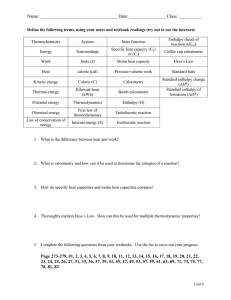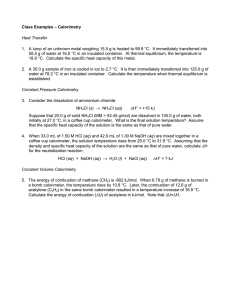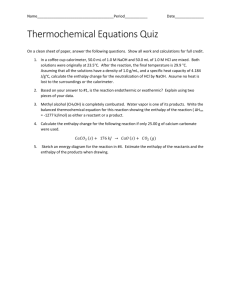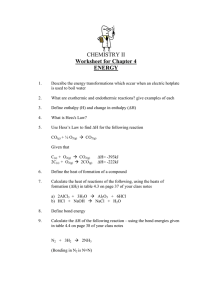Thermodynamics – Enthalpy of Reaction and Hess’s Law
advertisement
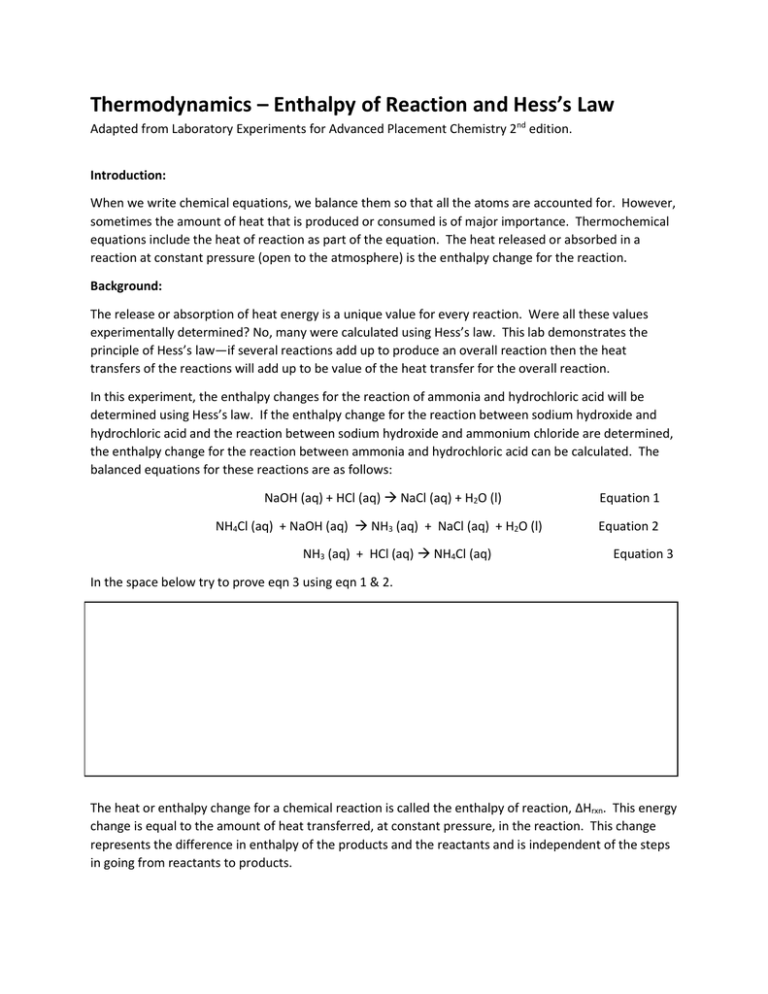
Thermodynamics – Enthalpy of Reaction and Hess’s Law Adapted from Laboratory Experiments for Advanced Placement Chemistry 2nd edition. Introduction: When we write chemical equations, we balance them so that all the atoms are accounted for. However, sometimes the amount of heat that is produced or consumed is of major importance. Thermochemical equations include the heat of reaction as part of the equation. The heat released or absorbed in a reaction at constant pressure (open to the atmosphere) is the enthalpy change for the reaction. Background: The release or absorption of heat energy is a unique value for every reaction. Were all these values experimentally determined? No, many were calculated using Hess’s law. This lab demonstrates the principle of Hess’s law—if several reactions add up to produce an overall reaction then the heat transfers of the reactions will add up to be value of the heat transfer for the overall reaction. In this experiment, the enthalpy changes for the reaction of ammonia and hydrochloric acid will be determined using Hess’s law. If the enthalpy change for the reaction between sodium hydroxide and hydrochloric acid and the reaction between sodium hydroxide and ammonium chloride are determined, the enthalpy change for the reaction between ammonia and hydrochloric acid can be calculated. The balanced equations for these reactions are as follows: NaOH (aq) + HCl (aq) NaCl (aq) + H2O (l) Equation 1 NH4Cl (aq) + NaOH (aq) NH3 (aq) + NaCl (aq) + H2O (l) Equation 2 NH3 (aq) + HCl (aq) NH4Cl (aq) Equation 3 In the space below try to prove eqn 3 using eqn 1 & 2. The heat or enthalpy change for a chemical reaction is called the enthalpy of reaction, ΔHrxn. This energy change is equal to the amount of heat transferred, at constant pressure, in the reaction. This change represents the difference in enthalpy of the products and the reactants and is independent of the steps in going from reactants to products. According to Hess’s law, if a reaction can be carried out in a series of steps, the sum of the enthalpies for each step equals the enthalpy change for the overall reaction. Another way of stating Hess’s law is: If a reaction is the sum of two or more other reactions, the ΔHrxn for the overall reaction must be the sum of the ΔHrxn values of the constituent reactions. In this laboratory experiment, the value for ΔHrxn eqn 1 minus the value of ΔHrxn for eqn 2 will equal the value of ΔHrxn for eqn 3. Unfortunately, there is no single instrument that can directly measure heat or enthalpy in the way a balance measures mass or a thermometer measures temperature. It is possible, however, to measure het change when a chemical reaction occurs. If the reaction occurs in solution, the heat change is calculated from the mass, temperature change, and specific heat of the solution, according to eqn 4. q = (grams of solution) x (specific heat of solution) x ΔT Equation 4 where q = heat energy gain or loss and ΔT is the temperature change in °C. Since ΔT equals the final temperature of the solution minus the initial temperature of the solution, an increase in solution temperature results in a positive value for both ΔT and q. A positive value of q means the solution gains heat, while a negative value means the solution loses heat. If the solution gains heat then the reaction “produces” heat and it is exothermic. The three reactions in this experiment are all acid-base neutralizations. Acid-base neutralizations are exothermic processes. Combining solutions containing an acid and a base results in a rise of solution temperature. The heat given off by the reaction is calculated using eqn 4. This heat quantity can be converted to the enthalpy of the reaction, in terms of kJ/mol, by using the concentrations of the reactants. When measuring the heat transfers for exothermic reactions using a calorimeter, most of the heat released is absorbed by the solution. A small amount of heat will be absorbed by the calorimeter itself. We will ignore this fact and assume that the calorimeter absorbs no heat. Procedure Set up your calorimeter according to the picture. Nest two (2) Styrofoam cups into the 250 mL beaker. Take the Styrofoam cup with the whole and invert it into the nested cups, to create a lid. The whole should be on the top, to insert the temperature probe into. Determine the Heats of Reaction for Eqn 1: HCl (aq) + NaOH (aq) NaCl (aq) + H2O(l) 1. Measure 50.0 mL of a 2.0 M HCl solution using a graduated cylinder and transfer the HCl solution into a calorimeter 2. Measure and record the initial temperature of HCl in the data table. 3. Rinse the graduated cylinder with distilled water. 4. Measure 50.0mL of a 2.0 M NaOH solution using a graduated cylinder 5. Measure and record the initial temperature of NaOH in the data table 6. Put a magnetic stirring bar into the calorimeter and start the bar spinning slowly in the HCl solution. 7. Quickly add the 50.0 mL of 2.0 M NaOH solution into the calorimeter, cover, and insert the thermometer. 8. Record the temperature every 20 seconds for a total of 3 minutes, in the data table. Reaction 2: NH4Cl (aq) + NaOH (aq) NH3 (aq) + NaCl (aq) + H2O(l) 9. Thoroughly rinse and dry the calorimeter, thermometer, stirrer bar, and graduated cylinder used for reaction 1. 10. Repeat steps 1-8 of reaction 1 using 2.0 M NH4Cl solution and 2.0 M NaOH solution. Reaction 3: NH3 (aq) + HCl (aq) NH4Cl(aq) PERFORM IN FUME HOOD 11. Thoroughly rinse and dry the calorimeter, thermometer, stirrer bar, and graduated cylinder used for reaction 2. 12. Repeat steps 1-8 of reaction 1 using 2.0 M NH3 solution and 2.0 M HCl solution. Be sure to complete this IN THE HOOD. DATA Reaction 1 Reaction 2 Reaction 3 1. Total mass of solution 2. 3. g g g g g g °C °C °C °C °C °C Final temperature, t2 Initial temperature, t1 4. Change in temperature, ΔT CALCULATIONS: Show all of your work. Box your answer, express it using appropriate sig figs, and include the appropriate unit. 5. Heat, ΔH, in kJ (q = ΔH) kJ 6. kJ kJ/mol kJ/mol ΔH / mol of one reactant (Divide your ΔH by 0.10 mol.) kJ kJ/mol 7. kJ Use Hess’ Law to calculate the ΔH / mol of Reaction 3. Copy Reactions 1 and 2. Write your calculated ΔH / mol value for each reaction next to its equation. Use Hess’ Law to obtain Reaction 3. Calculate the ΔH / mol of Reaction 3 using the enthalpies of Reactions 1 and 2. 8. Percent difference between calculated and measured values for Reaction 3 | Calculated – Measured | / Measured x 100%

